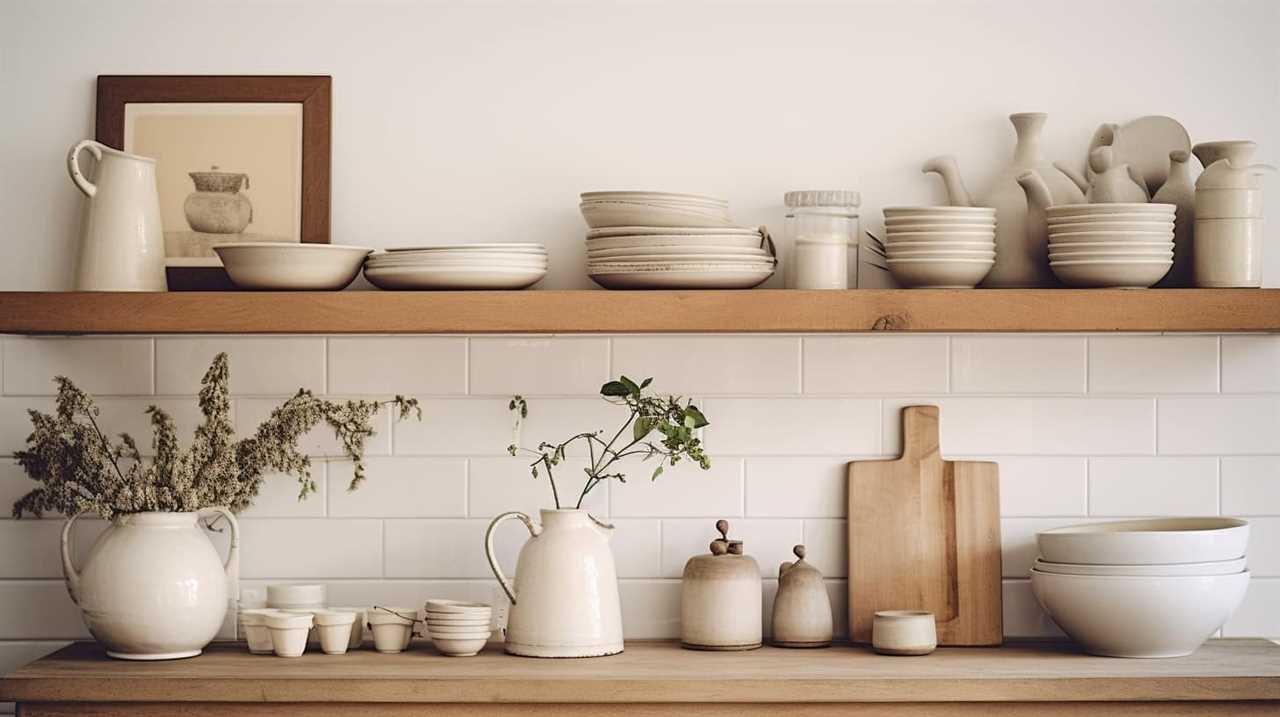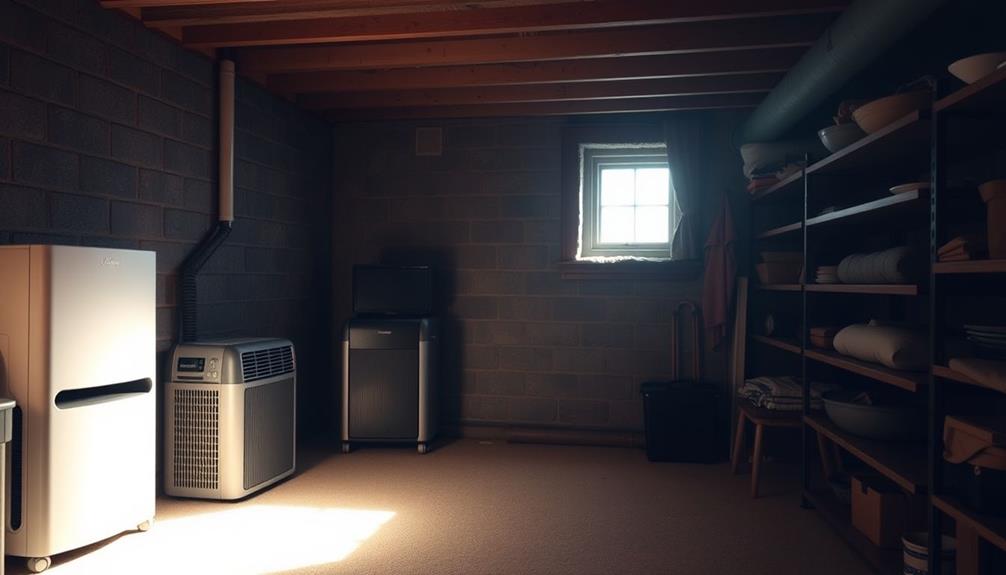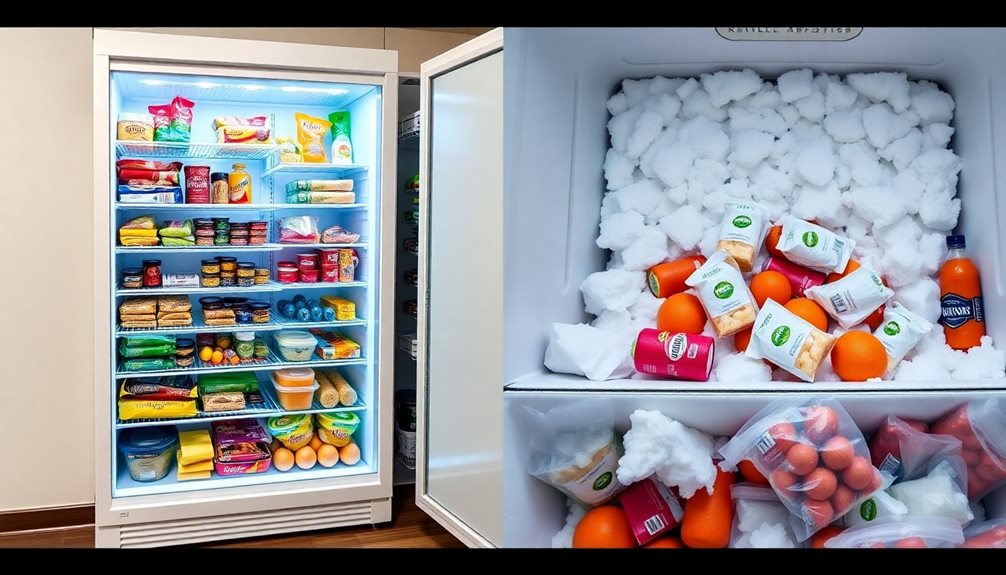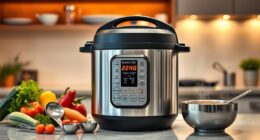Welcome to our guide on how to become an expert in using stainless steel appliances! We recognize your ambition to fully understand and control your stainless steel surfaces.
In this comprehensive cleaning guide, we will provide you with the knowledge and expertise to keep your appliances sparkling like new. From understanding the unique properties of stainless steel to tackling stubborn stains and fingerprints, we’ve got you covered.
We’ll also share tips on polishing and restoring the shine, as well as maintaining that pristine finish. By the end, you’ll be equipped with the skills and techniques to avoid common mistakes and achieve a flawlessly clean and shiny stainless steel appliance.
Let’s dive in and unlock the secrets to stainless steel mastery!

Key Takeaways
- Stainless steel surfaces come in different finishes: brushed, polished, and satin.
- Essential cleaning supplies for stainless steel surfaces include a microfiber cloth, stainless steel cleaner, vinegar spray bottle, and a soft-bristle brush.
- Proper cleaning techniques involve spraying the cleaner, wiping with the cloth in the direction of the grain, and using the brush for tougher stains.
- Select non-abrasive cleaners specifically designed for stainless steel and avoid harsh chemicals and abrasive scrubbing pads to prevent scratches and damage.
Understanding Stainless Steel Surfaces
One of the first things we need to understand about stainless steel surfaces is that they come in a variety of finishes. These finishes determine the appearance and characteristics of the stainless steel, and understanding them is crucial for proper maintenance and cleaning.
The most common finishes include brushed, polished, and satin. Brushed finishes have a textured appearance, with fine lines running in one direction, making them more resistant to scratches and fingerprints. Polished finishes, on the other hand, have a glossy, reflective surface that enhances the aesthetic appeal of the stainless steel. Satin finishes, also known as matte finishes, have a smooth, non-reflective surface that’s less prone to showing fingerprints and smudges.
The benefits of stainless steel surfaces extend beyond their visual appeal. Stainless steel is renowned for its durability and resistance to corrosion, making it a popular choice for kitchen appliances and fixtures. Additionally, stainless steel is non-porous, which means it’s resistant to stains and odors. This makes cleaning stainless steel surfaces relatively easy, requiring only mild soap and water. It’s important to note that abrasive cleaners and scrub brushes should be avoided, as they can scratch the surface of the stainless steel.
Gather the Necessary Cleaning Supplies
To properly clean stainless steel surfaces, we need to gather the necessary cleaning supplies. Cleaning tools play a crucial role in achieving a pristine finish on stainless steel appliances. Here are the essential supplies you’ll need to master the art of stainless steel cleaning.

First and foremost, a microfiber cloth is a must-have tool for cleaning stainless steel. Its soft and non-abrasive texture ensures a scratch-free cleaning experience. Microfiber cloths are highly effective in removing fingerprints, smudges, and stains from stainless steel surfaces. Additionally, they’re reusable and can be easily washed after each use.
Next, a gentle stainless steel cleaner is essential for tackling tougher stains and grime. Look for a cleaner specifically designed for stainless steel to ensure maximum effectiveness. It’s important to follow the manufacturer’s instructions when using the cleaner to avoid any damage to the surface.
In addition to the cloth and cleaner, a soft-bristle brush can be useful for cleaning hard-to-reach areas or removing stubborn residue. Be sure to choose a brush with soft bristles to prevent scratching the stainless steel surface.
Now that you have gathered the necessary cleaning supplies, it’s time to learn the proper cleaning techniques. Start by spraying the stainless steel cleaner onto the surface and use the microfiber cloth to wipe in the direction of the stainless steel grain. Avoid using circular motions as they can cause streaks and scratches. For tougher stains, use the soft-bristle brush in gentle, circular motions.

Preparing the Appliance for Cleaning
Let’s now turn our attention to preparing the stainless steel appliance for cleaning.
We’ll explore the various cleaning techniques that are most effective for stainless steel surfaces, as well as discuss how to choose the right products for the job.
Additionally, we’ll provide tips on preventing scratches and damage during the cleaning process.
Cleaning Techniques Explained
Before we begin cleaning our stainless steel appliances, let’s make sure we properly prepare them for the task at hand. To ensure a successful cleaning, there are a few cleaning hacks and natural cleaning solutions that can be used.

First, gather all the necessary supplies, such as microfiber cloths, mild dish soap, vinegar, and water.
Next, remove any loose dirt or debris from the surface using a soft cloth or brush. For stubborn stains or fingerprints, mix a solution of equal parts vinegar and water and apply it to the affected area.
Gently scrub the surface in the direction of the grain using a microfiber cloth. Rinse with clean water and dry thoroughly to prevent water spots.
Choosing the Right Products
To properly prepare our stainless steel appliances for cleaning, we’ll need to gather all the necessary supplies. Choosing the right cleaning products is crucial for achieving a pristine finish and avoiding common mistakes. When selecting cleaners for stainless steel, it’s important to opt for non-abrasive solutions specifically designed for this material. Avoid using harsh chemicals or abrasive scrubbing pads, as they can cause scratches and damage the surface. Look for cleaners that are labeled as safe for stainless steel and follow the manufacturer’s instructions for best results.

Additionally, microfiber cloths are ideal for cleaning stainless steel, as they’re gentle on the surface and won’t leave lint behind. By choosing the right cleaning products, we can ensure that our stainless steel appliances are properly cared for and maintained. This will help prevent scratches and damage, ensuring their longevity.
In the next section, we’ll discuss effective techniques for preventing scratches and damage to our stainless steel appliances.
Preventing Scratches and Damage
We can ensure the longevity of our stainless steel appliances by taking steps to prevent scratches and damage before cleaning them.
To protect against rust and water damage, follow these three essential tips:

- Use a soft cloth or sponge: When cleaning stainless steel appliances, avoid abrasive materials like steel wool or scrub brushes. Instead, opt for a soft cloth or sponge to gently remove any dirt or grime without scratching the surface.
- Wipe with the grain: Always wipe stainless steel appliances in the direction of the grain to minimize the risk of scratching. This technique helps maintain the appliance’s sleek appearance and prevents damage caused by wiping against the grain.
- Avoid harsh chemicals: Some cleaning products contain harsh chemicals that can damage the protective coating on stainless steel appliances. Stick to mild detergents or specialized stainless steel cleaners to ensure the appliance’s surface remains intact and resistant to rust and water damage.
Removing Grease and Food Residue
Now let’s tackle the challenge of removing grease and food residue from your stainless steel appliances.
We’ll provide you with the best cleaning techniques to effectively eliminate any buildup on the surface.
Additionally, we’ll share tips on how to prevent future residue, ensuring your appliances stay clean and pristine for longer periods of time.
Best Cleaning Techniques
One effective technique for removing grease and food residue from stainless steel appliances is using a vinegar and water solution. This eco-friendly cleaning option not only saves time but also ensures a streak-free shine.

Here are three steps to follow when using this technique:
- Mix equal parts vinegar and water in a spray bottle.
- Spray the solution onto the stainless steel surface.
- Wipe the surface with a microfiber cloth in the direction of the grain.
Vinegar’s acidity helps break down grease and food residue, while the water provides a gentle cleaning action. Avoid using abrasive cleaners or scrub brushes, as they can scratch the stainless steel surface. Remember to always dry the appliance thoroughly to prevent water spots.
Preventing Future Residue
To prevent future residue, it is important to establish a regular cleaning routine for your stainless steel appliances. By following these simple steps, you can maintain the pristine appearance of your appliances and prevent rust and water spots from forming.
First, remove any grease or food residue using a mild detergent or stainless steel cleaner. Wipe the surface in the direction of the grain to avoid scratching. Next, rinse with clean water and dry thoroughly with a soft cloth or towel.

To further protect against rust, apply a thin layer of stainless steel polish or oil. This will create a barrier and prevent moisture from coming into contact with the metal.
To remove water spots, mix equal parts vinegar and water in a spray bottle. Spray the solution onto the affected area and wipe clean with a microfiber cloth.
Remember, consistency is key in preventing future residue. By incorporating these cleaning techniques into your routine, you can keep your stainless steel appliances looking pristine for years to come.
| Steps | Action |
|---|---|
| 1 | Remove grease and food residue using a mild detergent or stainless steel cleaner. |
| 2 | Rinse with clean water and dry thoroughly with a soft cloth or towel. |
| 3 | Apply a thin layer of stainless steel polish or oil to prevent rust. |
| 4 | Remove water spots using a vinegar and water solution, then wipe clean with a microfiber cloth. |
Tackling Stubborn Stains and Fingerprints
How can we effectively remove stubborn stains and fingerprints from stainless steel appliances?

When it comes to tackling stubborn stains and fingerprints on stainless steel appliances, it’s important to use the right techniques and products. Here are three effective methods to get your appliances looking pristine:
- Vinegar and Water Solution: Create a mixture of equal parts vinegar and water in a spray bottle. Spray the solution onto a microfiber cloth and gently wipe the stained area. Vinegar’s acidic properties help break down the stains and fingerprints, leaving your stainless steel appliance shiny and clean.
- Baking Soda Paste: Make a paste by mixing baking soda with water. Apply the paste to the stained areas and let it sit for a few minutes. Then, use a soft cloth to scrub the stains in a circular motion. Baking soda is a gentle abrasive that can effectively remove stubborn stains without scratching the surface.
- Stainless Steel Cleaner: Invest in a high-quality stainless steel cleaner specifically designed for removing stains and fingerprints. Follow the manufacturer’s instructions and apply the cleaner to a microfiber cloth. Wipe the stained areas in the direction of the grain, and then buff with a dry cloth to achieve a streak-free finish.
Polishing and Restoring the Shine
To restore the shine and luster to your stainless steel appliances, we can use a simple household ingredient. One effective method for restoring the shine is to create a homemade polishing solution using vinegar and olive oil. Vinegar acts as a natural cleanser, while olive oil helps to add a protective layer and restore the stainless steel’s shine.
To create the polishing solution, mix equal parts vinegar and olive oil in a spray bottle. Spray the solution onto a microfiber cloth and gently wipe the stainless steel surface in the direction of the grain. This will help to remove any water spots and restore the luster of the appliance.
For a more visual representation, refer to the table below:

| Step | Ingredients | Instructions |
|---|---|---|
| 1 | Vinegar | Mix equal parts of vinegar and olive oil in a spray bottle. |
| 2 | Olive Oil | Spray the solution onto a microfiber cloth. |
| 3 | Microfiber Cloth | Gently wipe the stainless steel surface in the direction of the grain. |
Cleaning Stainless Steel Handles and Knobs
Let’s clean the stainless steel handles and knobs of our appliances. Cleaning these surfaces is essential to maintain the sleek and pristine appearance of our stainless steel appliances.
Here are three simple steps to effectively clean and remove fingerprints and smudges from stainless steel handles and knobs:
- Prepare a cleaning solution: Mix equal parts of warm water and mild dish soap in a spray bottle. This gentle solution will effectively remove dirt and grime without damaging the stainless steel surface.
- Spray and wipe: Spray the cleaning solution onto a microfiber cloth or soft sponge. Ensure the cloth or sponge is damp and not soaking wet. Gently wipe the stainless steel handles and knobs, following the grain of the metal. This will prevent any potential scratches and ensure a streak-free finish.
- Dry and polish: After wiping the surfaces, use a clean and dry microfiber cloth to remove any remaining moisture. To achieve a polished look, you can apply a small amount of stainless steel cleaner or olive oil to the cloth and buff the handles and knobs in circular motions.
Maintaining the Clean and Shiny Finish
To keep our stainless steel handles and knobs looking clean and shiny, we must regularly maintain their pristine appearance. Maintaining the shine of stainless steel appliances is crucial to preserving their aesthetic appeal and ensuring their longevity.
One effective way to maintain the shine is by regularly cleaning the surfaces with a mild detergent or stainless steel cleaner. This will help remove any smudges, fingerprints, or grease that may accumulate over time. It’s important to avoid using abrasive cleaners or scrubbing pads, as these can damage the stainless steel finish. Instead, opt for soft microfiber cloths or non-abrasive sponges to gently clean the surfaces.

Additionally, using a stainless steel polish can help restore the shine and provide a protective barrier against future smudges and fingerprints. When applying the polish, always follow the manufacturer’s instructions and use a clean, lint-free cloth.
Common Mistakes to Avoid When Cleaning Stainless Steel
One common mistake to avoid when cleaning stainless steel is using abrasive cleaners or scrubbing pads that can damage the finish. To achieve a streak-free shine, it’s important to choose the right cleaning tools and techniques. Here are three key points to keep in mind:
- Avoiding streaks: When cleaning stainless steel, it’s crucial to prevent streaks from forming. To do this, use a microfiber cloth or a soft sponge dampened with warm water. Avoid using paper towels or rough cloths, as these can leave behind lint or scratches.
- Choosing the right cleaning tools: Selecting the appropriate cleaning tools is essential for maintaining the pristine look of stainless steel appliances. Opt for non-abrasive cleaners specifically designed for stainless steel surfaces. Look for products that are pH-neutral and safe to use on stainless steel. Additionally, consider using stainless steel cleaning sprays or wipes, which are specifically formulated to remove fingerprints and smudges.
- Proper technique: When cleaning stainless steel, always remember to wipe in the direction of the grain. This helps to prevent the formation of streaks and ensures an even and clean finish. Avoid scrubbing vigorously, as this can potentially damage the surface of the stainless steel.
Frequently Asked Questions
How Often Should I Clean My Stainless Steel Appliances?
We find that regularly cleaning our stainless steel appliances is essential in maintaining their shine and preventing smudges. By following best practices for cleaning, such as using a microfiber cloth and gentle cleaning agents, we can remove fingerprints and dirt without scratching the surface.
We recommend cleaning our stainless steel appliances at least once a week to keep them looking their best. Consistency in cleaning will ensure that our appliances remain in pristine condition for years to come.

Can I Use Bleach or Other Harsh Chemicals to Clean Stainless Steel?
Using bleach or other harsh chemicals may seem like a quick and effective way to clean stainless steel appliances.
However, it’s important to note that these chemicals can actually damage the surface of the stainless steel.
Instead, we recommend using gentle cleaning solutions specifically designed for stainless steel.
These solutions are effective in removing dirt and grime without causing any harm.

Is It Necessary to Use a Specific Type of Cloth or Sponge to Clean Stainless Steel?
When it comes to cleaning stainless steel appliances, using a specific type of cloth or sponge is indeed necessary. Different methods can be used to remove fingerprints from stainless steel, but the best cleaning solution is one specifically designed for stainless steel surfaces.
Using the right cloth or sponge ensures that the appliance is cleaned effectively without causing any scratches or damage. It’s important to choose a cloth or sponge that’s gentle yet effective in removing dirt and grime from stainless steel appliances.
How Do I Remove Scratches From My Stainless Steel Appliances?
To repair scratched stainless steel appliances, we recommend using a commercial stainless steel cleaner or a homemade solution of vinegar and olive oil.
Gently rub the cleaner or solution onto the scratched area using a soft cloth, following the grain of the steel.

Rinse with water and dry thoroughly.
To prevent future scratches, avoid using abrasive cleaners or scrub brushes. Instead, use a microfiber cloth or sponge designed specifically for stainless steel cleaning.
Regularly cleaning and maintaining your appliances will help keep them looking pristine.
Can I Use Stainless Steel Cleaner on Other Surfaces Like Countertops or Sinks?
Yes, you can use stainless steel cleaner on other surfaces like countertops or sinks. However, it’s important to note that stainless steel cleaner is specifically formulated for stainless steel and may not be suitable for other materials.

When using stainless steel cleaner on glass surfaces, it’s best to test a small area first to ensure it doesn’t cause any damage.
For granite countertops, it’s recommended to use cleaning products specifically designed for granite to avoid any potential damage or discoloration.
Conclusion
In conclusion, mastering the cleaning process for stainless steel appliances is essential for maintaining their sleek and shiny appearance. By understanding the surfaces, gathering the right supplies, and following the proper steps, you can remove grease, stains, and fingerprints effectively.
Regular cleaning and polishing will restore the shine and ensure a clean and hygienic kitchen. Avoiding common mistakes will help preserve the stainless steel’s integrity and longevity.

So, dive into the cleaning process and enjoy the beauty of your stainless steel appliances for years to come.










